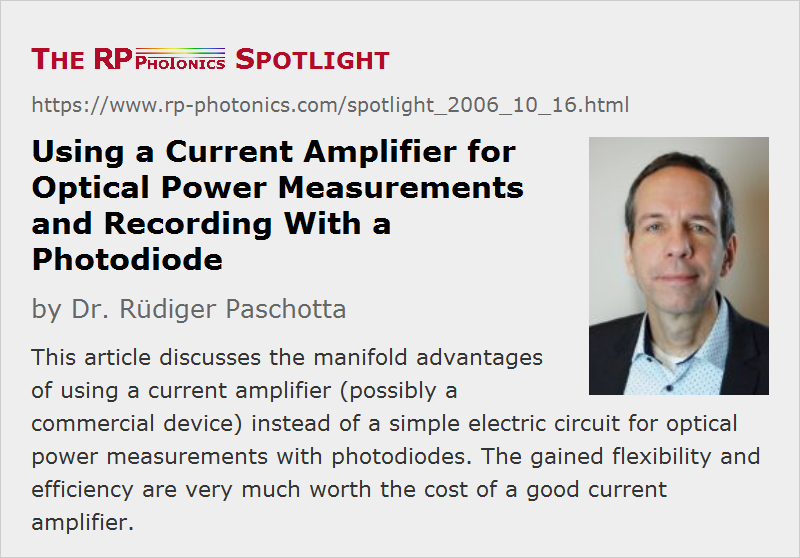Using a Current Amplifier for Optical Power Measurements and Recording With a Photodiode
Posted on 2006-10-16 as part of the Photonics Spotlight (available as e-mail newsletter!)
Permanent link: https://www.rp-photonics.com/spotlight_2006_10_16.html
Author: Dr. Rüdiger Paschotta, RP Photonics AG, RP Photonics AG
Abstract: This article discusses the manifold advantages of using a current amplifier (possibly a commercial device) instead of a simple electric circuit for optical power measurements with photodiodes. The gained flexibility and efficiency are very much worth the cost of a good current amplifier.

Ref.: encyclopedia article on photodiodes
Honestly, it looked to me like a complete overkill when many years ago a colleague of mine suggested to buy a commercial current amplifier (also called transimpedance amplifier) for various kinds of measurements with a photodiode in our laboratory. After all, couldn't I just use a very simple home-made circuit, consisting of nothing more than a small battery and a resistor? In this way I could apply some reverse voltage to the photodiode and convert the photocurrent into a voltage, which I could then easily measure with a multimeter or monitor with an oscilloscope. The cost for that would be a tiny fraction of that of a commercial current amplifier.
Well, in principle this works, but I soon learned to appreciate the advantages of the current amplifier:
- For all your photodiodes, you just have to have simple housings with no other electric parts (in particular, with no batteries which would run out during your measurements) and only a BNC connection to the current amplifier.
- The current amplifier usually has a lot of different sensitivity settings, spanning a huge dynamic range. Even in any particular setting, the dynamic range may be better than one usually gets with the mentioned simple circuit because of the low noise of the electronics and/or because you avoid the photodiode's dark current (for operation with zero bias voltage). So there is no more switching between three or four resistor values, often with no one being really suitable, and you get started very quickly.
- Your BNC cable may have a significant capacitance, but that will have a weaker influence on the possible measurement bandwidth than with the simple circuit.
- For photodiodes connected with different polarity, you just use the polarity setting on the current amplifier. No more switching of soldered connections just to get the right polarity!
- The current amplifier may have a built-in analog or digital display, making it unnecessary to find a multimeter, proper cables, another battery, etc.
- The luxury-type devices also contain filters with adjustable parameters. For example, you may use an appropriate low-pass filter to avoid aliasing effects on your digital scope, or a band-pass filter to discover some signal in noise centered at other frequencies. It can be extremely convenient to adjust the filter parameters with some finger tips, rather than resorting to the soldering iron each time.
- Other nice features are an adjustable bias voltage, an adjustable signal offset, rechargeable battery-powered operation for short-term (or in-the-field measurements), etc. All such features may improve your efficiency in the lab.
Having used this kind of equipment, never again would you bother to save some money by using a simple resistor/battery circuit instead of a current amplifier, when you need flexibility in the laboratory! You may, however, consider to build such a device yourself, or let your electronics support build one. If you don't require top performance, but need several of those devices in your lab, this can be a reasonable solution.
For high-speed applications or in cases where you need ultimate sensitivity, a universal current amplifier may no longer be suitable. Here, you have to get the amplifier as close as possible to your photodiode – ideally, built into the photodiode housing. For such purposes, there are reasonably prized current amplifier modules, if you don't want to get into the electronics details.
This article is a posting of the Photonics Spotlight, authored by Dr. Rüdiger Paschotta. You may link to this page and cite it, because its location is permanent. See also the RP Photonics Encyclopedia.
Note that you can also receive the articles in the form of a newsletter or with an RSS feed.
Questions and Comments from Users
Here you can submit questions and comments. As far as they get accepted by the author, they will appear above this paragraph together with the author’s answer. The author will decide on acceptance based on certain criteria. Essentially, the issue must be of sufficiently broad interest.
Please do not enter personal data here; we would otherwise delete it soon. (See also our privacy declaration.) If you wish to receive personal feedback or consultancy from the author, please contact him, e.g. via e-mail.
By submitting the information, you give your consent to the potential publication of your inputs on our website according to our rules. (If you later retract your consent, we will delete those inputs.) As your inputs are first reviewed by the author, they may be published with some delay.


Connect and share this with your network:
Follow our specific LinkedIn pages for more insights and updates: